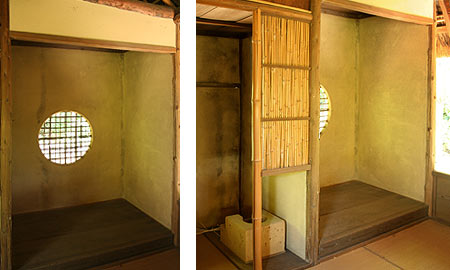| Also written ~°; also marumadodoko Ϋ°.
A circular window placed in the center of the rear wall of an alcove *tokonoma
°ΜΤ, in a tea ceremony house. *Shouji
αq that can be opened right and left during the performance of a tea ceremony
. When the tea ceremony room *chashitsu
Ί is not in use the shouji are closed. Furthermore, the circular opening
may enclose space that contains a Buddhist altar or a statue of a famous tea master.
Another type of circular window is filled with small bamboo that is usually entwined
with a dried vine. The bamboo and vine run both vertically and horizontally in
the rear wall of the alcove. Sometimes a thin board about 15cm wide is set in
the center of the round window and a flower vase is hung on a nail inserted into
the board. Examples: Nanshuuji Daikoku'an μ@εΑ, Osaka; Koudaiji Shiguretei δJΰ,
Kyoto; Kainyo'an F@Α at Saigyou'an ΌsΑ, Kyoto. |



